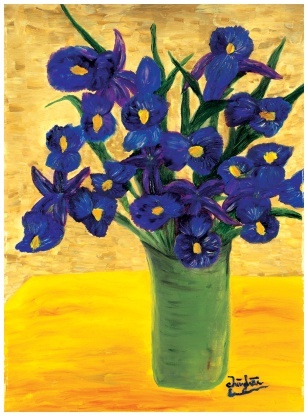The Flower in the Heart Will Not Wither
 |
As I was reading a fairy tale entitled Iris by Hermann Hesse, the first few pages immediately reminded me of Master's Iris painting. The beautiful blue and purple flowers with the bright golden background that create a surreal radiant aura effect leave the observer memorized.
The plump iris flowers are so alive and full of energy, as if they are about to burst into laughter and lead you to endless childish adventures. You feel as if the flowers are opening up to you in order to cheer you up, as well as fill your heart with childlike innocence and enthusiasm for life. This is exactly what the iris flower represents in Hermann Hesse's story: a symbol of childhood, "an open gate through which the soul, if it is ready, can enter into the inner part of the world, where you and I and day and night are all one."
The story Iris is about a young boy who adored the Iris in his family's garden. Though there were many other flowers in the garden, the Iris was especially important to him, because "it became everything worth contemplating and everything that was miraculous." He often stared at the Iris and drifted off into a dreamlike state, where he could feel the oneness of the universe and the blissfulness of life.
However, when the boy grew up, he became a man deeply engaged in the outer world; thus he completely forgot about what the Iris symbolized. Later he became a famous scholar, a professor who was respected by many, but in his heart, he was unhappy and discontented. This feeling began to dispel as his attraction grew towards a special girl named Iris.
Her name reminded him of something deep, distant and important; but he could not pinpoint what exactly he was feeling. He eventually asked Iris to marry him, but Iris turned down his proposal, stating, "I can live without flowers and also without music ... however, there's one thing which I can't and won't do without: I can never live, not even just for a day, if the music in my heart is not at the core of everything I do." Iris demanded that he find his inner self before she would accept his proposal. With reluctance, the man agreed and embarked on an inner journey of self-discovery.
Some years passed and the man developed a new sensitivity to life and became tender. But before he completed the mission, Iris became ill and was dying. Before she died, she gave him an iris and told him, "Search for me ... search for the iris. Then you'll come to me." He continued searching. Eventually, the man rediscovered his childhood dream and became fully alive again through the Iris. "He began to sing softly, and his path sloped gently towards home."
I wonder if this is one of the reasons
why Master named this painting "The Flower in the Heart Will Not
Wither," because it is the heart of a child which is truly free and
represents the true Self. In a way, I think Hermann Hesse's fairly tale
"Iris" and Master's painting depict the same truth that is beyond
time and space.![]()
| << | Contents | >> |
|
Refer this page to friends
|
||